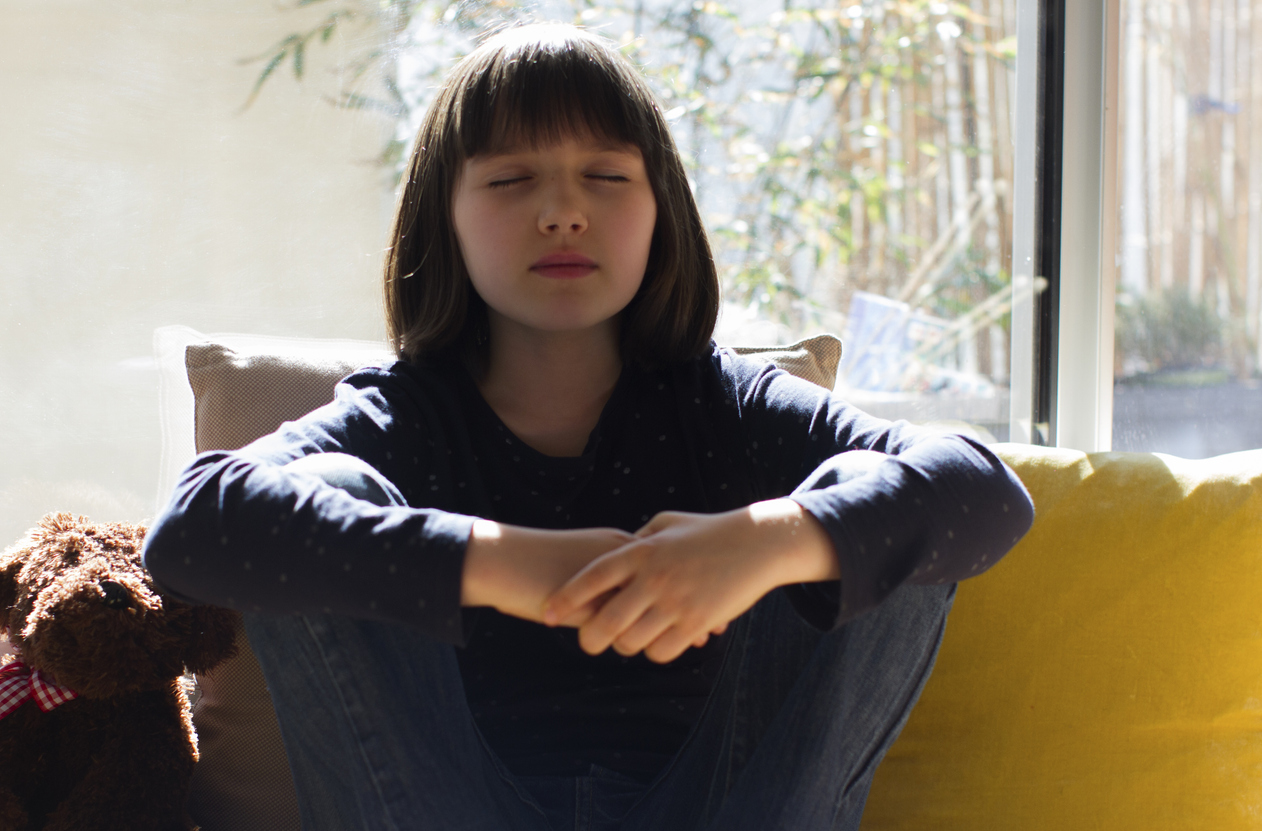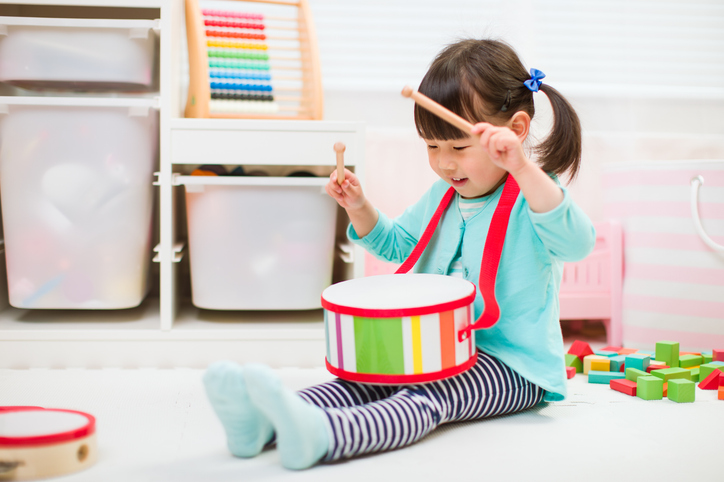How to Teach Children to Regulate Their Emotions

I’ll never forget the moment I finally realized how to handle my daughter’s tantrums. How to calm her down and teach her to calm herself down.
At that moment, I’m standing in line at the grocery store, in the Inuit town of Kugaaruk, Canada, about 150 miles above the Arctic Circle. My 3-year-old daughter, Rosy, is with me. She sees a rainbow headband she desperately wants and begins her third emotional outburst of the day.
“But, Mama, I neeeeeeeed it! I neeeeeed it!” Rosy screams. I look around, and several women in the store are already staring at us. I launch into my usual routine: a combination of sternness, rational logic, and demands for her to stop whining. “Sorry, Rosy, we do not need another headband,” I say, with anger rising in my voice. Rosy reciprocates with even more anger of her own. She cries loudly and flails her arms. She’s losing control of her emotions. And so am I.
Thank goodness Elizabeth Tegumiar is with us. Elizabeth grew up in this town and is highly knowledgeable about traditional Inuit parenting techniques, including a sophisticated approach to teaching children how to control their emotions. For the past week, Elizabeth has been interpreting interviews with Inuit elders from their native language, Inuktitut, to English. But along the way, she has been giving me a huge gift: She has been showing me how to calm Rosy down.
In this moment, standing in the grocery store line, Elizabeth does just that: she stops Rosy’s tantrum, quickly and effortlessly.
Oh goodness, I think to myself as I watch Elizabeth. I’ve been handling Rosy’s emotional outbursts all wrong. I should be doing the opposite of what I’ve been doing.
Tools of the Tantrum Trade
For the past four years, I’ve been studying how parents around the world teach young children to regulate their emotions. I’ve studied oodles of psychological and anthropological studies. And I’ve learned firsthand from parents in three of the most revered cultures—the Inuit in the Arctic, the Maya in the Yucatan, and the Hadzabe in Tanzania.
Turns out, teaching children to control their anger is easier than I thought. All I really needed was three tools: calmness, physicality, and awe. These tools not only settle down a tantruming child in the moment, but they also teach the child how to calm themselves down on their own. So over time, the tantrums decrease in intensity and frequency. (Rosy went from having a tantrum almost every day to only one or two each month.)
Tool #1: Calmness
This tool is the most powerful one we have in our parenting toolbox. It works wonders on kids of all ages, even middle-age ones still trying to regulate their own emotions (including the author of this essay).
When a child is upset, as a parent, all we want to do is help them (and make the noise stop as quickly as possible). Our knee-jerk reaction is often to issue many verbal instructions, including requests (“Please stop crying!), questions (e.g. “What’s wrong?”) and logical explanations (“But we already have an ice cream. Why do we need two?”).
There’s one big problem with this approach: it often exacerbates the problem. The child simply gets more upset.
In many cultures around the world, parents take the opposite approach: they interact with an upset child from a place of the utmost calm. Seriously. I’m talking about lying-facedown-on-a-massage-table calmness.
When a toddler has a tantrum or an older child loses control of their emotions, parents say very few words (words are stimulating). They make very few movements (movement is stimulating). And they show very little expression on their faces (again, emotion is stimulating). Parents approach the child the way you might approach a butterfly on your shoulder: Slowly. Gently. Softly.
Anthropologist Jean Briggs documented this style of parenting several times during her stay with an Inuit family in the 1960s. “There was consistency also in the calmly rational quality of the adults’ responses to childish misbehavior,” Briggs wrote in the book Never in Anger. “When Saarak [a three-year-old girl] hit at her [mom’s] face with a spoon, she turned her head away, saying calmly, ‘She has no reason (ihuma).’”
The sheer act of the parent being calm has a massive influence on an upset child, psychologists have told me, not just in the moment, but over the long run.
Children’s emotions—and energy level—mirror those of their parents. The human brain contains neurons and circuitry with the sole purpose of doing just that. “Emotions are contagious,” says child psychotherapist Tina Payne Bryson.
So if you want your child to have high energy, then have high energy yourself. Give them instructions. Talk to them with urgency. Raise your voice. Repeat your request. Be intense.
But if you want your child to be calm, be calm yourself. Be quiet. Be still. Be tender. Stand near the child to show them you are there for them. Maybe, if needed, touch the child lightly on the shoulder. But otherwise, show them how to be calm (instead of telling them about it).
Every time the child goes from being upset to settling themselves down, they practice this skill. Over time, the child learns to calm down without the parent’s aid. Their tantrums will happen less frequently and, when they do arise, they will resolve more quickly. Eventually, after a few months, they almost disappear completely.
“What’s really cool is if you get a lot of practice going from a kind of falling-apart, stressed state back into a controlled state with the help of [a] parent, your brain learns how to do that on its own,” Payne-Bryson says. “So it’s very much about skill building.”
In other words, emotional outbursts and tantrums are actually wonderful opportunities for your child—opportunities to increase their ability to control their emotions and handle frustrations with calmness and grace.
Tool #2: Physicality
On our second night in the Arctic, one of the moms shows me just how powerful the physicality tool can be with an upset child. Sally Kukkuvak and I are watching her grandson, who’s only 18 months old. At one point, the little boy grabs the tail of their mini Yorkshire Terrier, Missy, so Sally picks him up. Upset and screaming, the toddler scratches Sally’s face so hard that it draws blood. Instead of yelling or punishing the boy, Sally stays calm (see a pattern here?) and executes the physicality tool.
She slowly flips the toddler onto his stomach and gently pats his butt a few times, like you’d pat a rump roast before cooking it. “Ow, that hurt me,” she says with a sweet, quiet voice. “We don’t hurt people.” Then she flies him in a circle, like an airplane. Caleb giggles. His urge to scratch has vanished. His anger evaporates. And Sally, through physicality, has calmed him—while also showing him who’s strong and loving (a.k.a., who’s the boss).
I saw a similar technique practiced in Tanzania when we stayed with Hadzabe families. When a toddler started to have a tantrum, her mother simply walked over to the little girl, calmly, and gently touched the child’s shoulder. The mom stayed silent and still. After about 30 seconds, the little girl hugged the mom’s leg and settled herself down.
“Physical touch breaks the tension between a child and parent,” says psychologist Dr. Larry Cohen. “Children have a natural urge to cooperate. They love to please you. And when that’s not happening, it’s because they’re overloaded with tension.”
From a scientific perspective, there are oodles of reasons to parent with physicality. Touch lights up a child’s brain like fireworks. Roughhousing, like Sally did with her grandson, releases a chemical in the brain, called BDNF, which helps the brain mature and grow. A tender, gentle touch, like the Hadzabe mom used, releases the “cuddle” hormone oxytocin, which signals safety and love to a child. This low-energy type of physicality soothes a child’s nervous system and brings the energy way down. The child can find that low-energy state in themselves. Over time, through this practice, they build up the ability to soothe themselves and eventually regulate their anger in the first place.
So the next time your child is upset—doesn’t matter their age—try this: Take one deep breath. Stay calm. Walk over to the child. (If they are small, bend over.) Then gently put your hand on their shoulder. Maybe rub their shoulders softly. Or give them a light kiss. But stay silent and wait. Wait for them to settle themselves down. You might be surprised how quickly they do it.
Tool #3: Awe
This tool doesn’t just cool a hot temper, it also helps stop complaining, whining and all sorts of negative emotions. And to be honest, this tool has been just as transformative for me as it has been for Rosy.
One evening, Elizabeth, Rosy, and I are walking back to Sally’s house after a long day of interviews. It’s about 10 p.m., and the sun hangs low over the bay. As it sets slowly—very, very slowly—it paints the clouds pink and purple.
Rosy is cranky with tiredness. She sits down in the road and begins to whine. Elizabeth walks over to her, kneels down, and says with the brightest wonderment in her voice, “Look at the beautiful sunset. Do you see the pink? The purple?” Rosy looks over at Elizabeth suspiciously. Her brow furrows. But she can’t resist Elizabeth’s sweetness—nor the sunset. Rosy turns to look at the sky. And her whole expression changes. Her eyes soften. The crying stops. And she stands up and starts walking.
Elizabeth is practicing an incredibly sophisticated psychological tool with Rosy: she’s replacing anger with awe.
Awe is the feeling that occurs when you encounter something unexpected, unexplainable, and extraordinary. That feeling has all sorts of benefits. It makes you more cooperative, calms your nervous system, and relieves stress, psychologists have found.
“The next time you are outside walking, take a moment and find a crack in the sidewalk where there is a weed poking out and attempt to create the feeling of awe—awe at the power of nature,” says Lisa Feldman Barrett, a psychologist at Northeastern University. “Practice that feeling over and over again. Practice feeling awe at the sight of a butterfly. Or the sight of a particular lovely flower. Or at the clouds in the sky.”
As Barrett views it, emotions act a bit like muscles. If you don’t use them, you lose them. And the more you flex particular ones, the stronger they become. The more you experience awe—the more you flex this neural muscle in your brain—the easier it becomes to access this emotion in the future. When you start to feel an unproductive emotion, such as anger, you can more easily swap that negative feeling for a positive one, such as awe. When you feel annoyed, you can swap it for gratitude.
“For example, when I am video chatting with somebody in China, I can feel irritated very easily when the connection isn’t very good,” Barrett says, “Or I can feel awe at the fact that someone can be halfway around the world, and I can see their face and hear their voice, even if it is imperfect, and I can be grateful for that ability.”
Under the purple sunset, Elizabeth does exactly this with Rosy. By pointing out the incredible sunset, she helps Rosy replace her negative feelings with a positive one. In the process, she helps Rosy regulate her emotions—not just in the moment, but also in the future, too.
“It may sound hokey in the abstract, but I guarantee it, that if you practice awe, that practice is essentially helping to rewire the brain. So that you can make that emotion [awe or gratitude] much more easily in the future,” Barrett says.
This practice is especially important for children because their brains are malleable. “Children’s brains are waiting for wiring instructions from the world,” she says.
Credit/Permission
Adapted from Hunt, Gather, Parent: What Ancient Cultures Can Teach Us About the Lost Art of Raising Happy, Helpful Little Humans. Published by Avid Reader Press / Simon & Schuster. Copyright 2021 by Michaeleen Doucleff, Ph.D.
Works Cited
Briggs, Jean L. Never in Anger: Portrait of an Eskimo Family. Harvard University Press, 1970.
Feldman Barrett, Lisa. How Emotions Are Made: The Secret Life of the Brain. Houghton Mifflin Harcourt, 2017.
Michaeleen Doucleff, Ph.D., is a correspondent for NPR’s Science Desk. She is the author of Hunt, Gather, Parent: What Ancient Cultures Can Teach Us About the Lost Art of Raising Happy, Helpful Little Humans.
This article first appeared in the 2022 issue of the Parents League Review. Get the current issue of the Review free with a family membership. Or purchase it separately.











